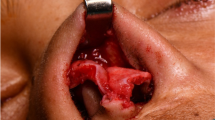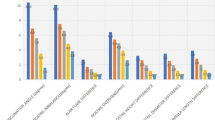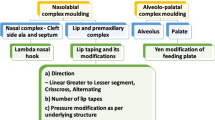Abstract
Background
Osteocartilaginous deformities in cleft rhinoplasties may be restored with numerous techniques. However, the anteroposterior (AP) diameter lengths of the nostrils may still be unequal and should also be addressed. A technique was designed to balance nostril AP diameter lengths and apical shapes.
Materials and Methods
Balance between AP nostril diameters was accomplished by reduction of the AP diameter of the nostril at the non-cleft side by medial crural reduction and augmentation of the AP diameter of the nostril at the cleft side by three-parted mini-flap reconstruction at the soft triangle. The cleft-side AP diameter length was divided by the non-cleft-side AP diameter length of the same preoperative, per-operative and 1-year postoperative base view photographs of each patient, and “nostril balancing ratio” was obtained. The more this ratio was near to “one,” the more the AP nostril diameters were equal.
Results
Seventy-eight unilateral-cleft rhinoplasty were performed between January/2019 and May/2022. Forty-two of them required nostril AP diameter equalization. Twenty-nine patients were female, thirteen were male. Thirty-three of them were operated for a primary cleft rhinoplasty. Nine of them for secondary cleft rhinoplasty. Mean age was 28 years (22–39 years). Mean follow-up was 25 months (6–40 months). The preoperative, per-operative and postoperative mean “nostril balancing ratios” were 0.714 (0.621–0.813), 0.743 (0.721–0.752) and 0.971 (0.943–0.976), respectively.
Conclusion
Balancing AP diameter symmetry with MCO at the non-cleft side and three-parted mini skin flap reconstruction at the cleft side may provide the satisfactory results. Three mini-flaps at the soft triangle may remold the nostril apex in an oval shape, which may result in a better shape symmetry.
Level of Evidence IV
This journal requires that authors assign a level of evidence to each article. For a full description of these Evidence-Based Medicine ratings, please refer to the Table of Contents or the online Instructions to Authors www.springer.com/00266.












Similar content being viewed by others
References
Hoshal SG, Solis RN, Tollefson TT (2020) Controversies in cleft rhinoplasty. Facial Plast Surg 36(01):102–111
Rohrich RJ, Adams WP, Ahmad J, Gunter J (2014) Dallas rhinoplasty: nasal surgery by the masters: CRC Press
Cho BC, Lee JW, Lee JS, Lee JH, Ryu JY, Tian L et al (2021) Correction of secondary unilateral cleft lip nasal deformity in adults using lower lateral cartilage repositioning, columellar strut, and onlay cartilage graft on the nasal tip with open rhinoplasty combined with a reverse-U incision. J Plast Reconstr Aesthet Surg 74(5):1077–1086
Richardson S, Khandeparker RVS (2021) Cleft rhinoplasty. Oral and maxillofacial surgery for the Clinician. 1703-32
Raymond WT, Mercan E, Fisher DM, Hopper RA, Birgfeld CB, Gruss JS (2019) Unilateral cleft lip nasal deformity: foundation-based approach to primary rhinoplasty. Plast Reconstr Surg 144(5):1138–1149
Tse RW, Knight R, Oestreich M, Rosser M, Mercan E (2020) Unilateral cleft lip nasal deformity: three-dimensional analysis of the primary deformity and longitudinal changes following primary correction of the nasal foundation. Plast Reconstr Surg 145(1):185–199
Etöz BÇ, Etöz A, Ercan I (2008) Nasal shapes and related differences in nostril forms: a morphometric analysis in young adults. J Craniofac Surg 19(5):1402–1408
Ozkan B, Albayati A, Akinci K, Uysal CA, Ertas NM (2020) A custom-made nostril retainer for adult population. J Craniofac Surg 31(6):e533–e534
Koh KS, Eom JS (1999) Asymmetric incision for open rhinoplasty in cleft lip nasal deformity. Plast Reconstr Surg 103(7):1835–1838
Guyuron B, Ghavami A, Wishnek SM (2005) Components of the short nostril. Plast Reconstr Surg 116(5):1517–24. https://doi.org/10.1097/01.prs.0000182590.01431.3d
Guyuron B (2008) MOC-PS(SM) CME article: late cleft lip nasal deformity. Plast Reconstr Surg 121(4 suppl):1–11. https://doi.org/10.1097/01.prs.0000305955.67554.40
Wang H, Fan F, You J, Wang S (2012) Correction of unilateral cleft lip nose deformity using nasal alar rim flap. J Craniofac Surg 23(5):1378–1381
Agarwal R, Chandra R (2012) Alar web in cleft lip nose deformity: study in adult unilateral clefts. J Craniofac Surg 23(5):1349–1354
Zhang Z, Huang TC, He Y, Li S, Li Z, Chen J, Cen Y, Qing Y (2021) Modified use of costal cartilage in Asians for the correction of nostril asymmetry in unilateral secondary cleft lip nasal deformity. Ann Plast Surg 86(2):175–181. https://doi.org/10.1097/SAP.0000000000002503
Suh JM, Uhm KI (2021) Change in nostril ratio after cleft rhinoplasty: correction of nostril stenosis with full-thickness skin graft. Arch Craniofac Surg 22(2):85–92. https://doi.org/10.7181/acfs.2021.00010
Lipsett EM (1959) A new approach to surgery of the lower cartilaginous vault. AMA Arch Otolaryngol 70(1):42–47
Özkan AÇ, Mete FS (2019) Classification of angulation deformities of lower lateral cartilages and their restoration. J Craniofac Surg 30(8):2473–2478
Rohrich RJ, Shanmugakrishnan RR, Mohan R (2020) Rhinoplasty refinements: addressing the deviated overprojected nose. Plast Reconstr Surg 146(3):292e-e295
Apaydin F (2016) Projection and deprojection techniques in rhinoplasty. Clin Plast Surg 43(1):151–168
Gubisch W, Eichhorn-Sens J (2008) The sliding technique: a method to treat the overprojected nasal tip. Aesthetic Plast Surg 32(5):772–778
Darzi E, Sadeghi M, Amali A, Saedi B (2021) Effect of lateral crura cut overlay and medial crura cut and overlay in creating and maintaining tip projection and rotation: a randomized single-blind trial. Br J Oral Maxillofac Surg 59(9):1067–1073
Nicksic PJ, Pfaff MJ, Ayeroff JR, Lee JC (2018) Management of the cleft nasal tip: an overview of classic techniques and strategies. Ann Plast Surg 80(5):581–586
Cingi C, Muluk NB, Winkler A, Thomas JR (2018) Nasal tip grafts. J Craniofac Surg 29(7):1914–1921
Han J, Baek R-M, Kim B-K (2017) Lateral crural reinforcement in secondary cleft lip nasal deformity through a combined lateral crural turn-over flap and strut graft. Ann Plast Surg 79(1):28–33
Isaac KV, Tan RA, Ganske IM, Mulliken JB (2019) Beware the alar base optical illusion in assessment of unilateral cleft lip nasal deformity. Plast Reconstr Surg 143(4):1157–1162
Choi JY (2018) Alar base reduction and alar-columellar relationship. Facial Plast Surg Clin 26(3):367–375
Balaji N (2020) Alar base surgery. In: Textbook of nasal tip rhinoplasty, Springer, p. 271-83
Sazgar AA, Golparvaran S, Sazgar AK, Teimouri Y, Mirashrafi F (2020) Morphological classification of nostrils and the role of sill augmentation. Aesthet Plast Surg 44(6):2199–2207
Kim YB, Nam SM, Park ES, Choi CY, Kang MS, Cha HG (2021) The effects of alar base augmentation in secondary unilateral cleft lip nasal deformity. J Craniofac Surg 32(2):525–529
Adham G, Keyhan SO, Fallahi HR, Ziaei H, Thomas M (2021) Nasal sill augmentation: an overlooked concept in rhinoplasty: a technical note and review of the literatures. Maxillofac Plast Reconstr Surg 43(1):1–15
Gubisch W (1998) The triple swing flap technique to correct the asymmetry of unilateral cleft lip nose deformities. Scand J Plast Reconstr Surg Hand Surg 32(3):287–294
Author information
Authors and Affiliations
Corresponding author
Ethics declarations
Conflict of interest
The authors declare that they have no conflict of interest.
Human or Animal Rights
This article does not contain any studies with human participants or animals performed by any of the authors.
Additional information
Publisher's Note
Springer Nature remains neutral with regard to jurisdictional claims in published maps and institutional affiliations.
Rights and permissions
Springer Nature or its licensor (e.g. a society or other partner) holds exclusive rights to this article under a publishing agreement with the author(s) or other rightsholder(s); author self-archiving of the accepted manuscript version of this article is solely governed by the terms of such publishing agreement and applicable law.
About this article
Cite this article
ÇERÇİ ÖZKAN, A., BİLGİLİ, A.M. & KOZANOĞLU, E. Balancing the Anteroposterior Diameters of the Nostril Lengths in Cleft Rhinoplasty. Aesth Plast Surg 47, 1513–1524 (2023). https://doi.org/10.1007/s00266-022-03153-6
Received:
Accepted:
Published:
Issue Date:
DOI: https://doi.org/10.1007/s00266-022-03153-6




